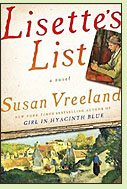Lisette's List
by Susan Vreeland
Reviewed by Margaret Tomlinson

Lisette's List looks at the post-Impressionist art of Pissarro, Cézanne, Chagall and Picasso through the eyes of a young woman who in 1937 moves from her beloved Paris to the small Provençal village of Roussillon. Her husband's father, who once worked in the Roussillon ochre mines, has begged the couple to come and take care of him in his dying days. Newlywed Lisette goes with her husband, but is bitter about leaving Paris and giving up her "chance of a lifetime," an opportunity to apprentice in an art gallery. Her father-in-law, however, owns seven paintings he acquired in his youth after trading his work as a miner for a job selling pigments made from the ochre from the mines. Lisette begins to study the paintings.
Color is a constant presence in the novel. Lisette's father-in-law insists she learn the names of the pigments used in his paintings: "Six roofs, ocre rouge. Five chimneys, jaune nankin clair. Six fields on the hillside behind - vert foncé, green so rich and dark it must have been spinach growing there..." The landscape of Roussillon, with its ochre canyons, is as rich with color as the paintings: "Red and orange pinnacles and curving passageways ... scoured clean by wind and quarrymen." Along with the grief and dangers that World War II brings, comes Lisette's predictable realization that she has begun to love Roussillon as dearly as Paris.
Lisette is drawn with broad brushstrokes, a pouty, naïve, self-centered young woman who gradually matures into a caring friend. As she learns more about the paintings and later meets Marc Chagall and his wife, Jews fleeing from the Nazis, readers of Lisette's List receive an education - perhaps a little too pat - in how to view post-Impressionist art. To her "List of Hungers and Vows," Lisette adds "Learn what makes a painting great." Although she collects ideas, she never discovers a precise formula, which should come as a relief to readers who care about art. (2014, 141 pages including an Afterword about the history behind the novel)
More about Lisette's List at Powell's Books or Amazon.comOther novels about art during the WWII era:
Pictures at an Exhibition by Sara Houghteling (2009), about a Jewish art dealer's son who returns to Paris at the end of World War II and begins an obsessive search for the paintings looted from his father's shop by the Nazis. More info
The Woman Who Heard Color by Kelly Jones (2011), about a German woman with synesthesia (she sees colors when she hears sounds) who gets a job in a Jewish art gallery, where she encounters the young Hitler. More info
Success by Lion Feuchtwanger (1930), about an art museum curator persecuted by the Nazi regime; a contemporary novel at the time it was written. More info
Nonfiction about the Nazis and art:
The Faustian Bargain: The Art World in Nazi Germany by Jonathan Petropoulos (2000). More info
The Rape of Europa: The Fate of Europe's Treasures in the Third Reich and the Second World War by Lynn H. Nicholas (1994). More info
The Monuments Men: Allied Heroes, Nazi Thieves and the Greatest Treasure Hunt in History by Robert M. Edsel (2010). More info
At the Movies:
The Monuments Men
Online:
www.lootedart.com, a website devoted to information about art looted by the Nazis during the World War II era
Back to: World War II Home Front, Europe
Back to: Directory of Book Reviews